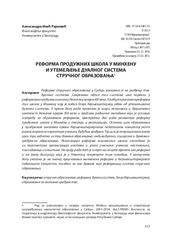Prikaz osnovnih podataka o dokumentu
Reforma produžnih škola u Minhenu i utemeljenje dualnog sistema stručnog obrazovanja
The reform of the continuation schools in Munich and the establishment of the dual system in vocational education
| dc.creator | Ilić-Rajković, Aleksandra | |
| dc.date.accessioned | 2021-10-12T12:04:58Z | |
| dc.date.available | 2021-10-12T12:04:58Z | |
| dc.date.issued | 2015 | |
| dc.identifier.issn | 0547-3330 | |
| dc.identifier.uri | http://reff.f.bg.ac.rs/handle/123456789/1932 | |
| dc.description.abstract | Reforma stručnog obrazovanja u Srbiji usmerena je ka uvođenju tzv. dualnog sistema. Savremeni oblik tog sistema ima poreklo u reformama produžnih škola u Nemačkoj krajem XIX veka. U radu je prikazana reforma tih škola u Minhenu koju je vodio Georg Keršenštajner, jedan od utemeljivača dualnog sistema. U prvom delu rada prikazan je širi ekonomski i društveni kontekst Nemačke krajem XIX veka i problem radničke omladine koji je uslovio potrebu za obrazovnom reformom. Centralni deo rada razmatra reformu produžnih škola u Minhenu u teoriji i realizaciji. Osnovni cilj obrazovanja u produžnim školama prema Keršenštajnerovom pedagoškom konceptu jeste razvoj moralnog karaktera učenika, budućih građana. Taj cilj je operacionalizovan kroz tri zadatka iz tri domena obrazovanja: individualno, socijalno i državno- građansko obrazovanje. Realizacija reforme minhenskih škola sagledana je iz perspektive organizacije nastave i uloga učesnika: učenika, nastavnika, poslodavaca i opština. Na kraju rada dat je osvrt na opšte efekte ove reforme i na javnu diskusiju koja je u Nemačkoj pokrenuta tim povodom. U zaključnom delu ukazano je na značaj proučavanja minhenske reforme i Keršenštajnerovog pedagoškog koncepta, posebno za one države koje reformišu sistem stručnog obrazovanja. | sr |
| dc.description.abstract | The reform of vocational education in Serbia is focused on the introduction of the so called dual system. The current form of this system originates from the reforms of the continuation schools in Germany near the end of the nineteenth century. The paper presents the reform of these schools led by Georg Kerschensteiner, one of the founders of the dual system. The first part of the article is devoted to a wider economic and social context in Germany at the end of the nineteenth century and the problem of the working - class young people, which led to the educational reform. The central part of the paper considers the reform of the continuation schools in Munich from the theoretical aspect and the aspect of the realization. The main goal of education in continuation schools, according to Kerschensteiner's pedagogic concept is the development of moral character of students, future citizens. The goal was to be achieved through three tasks in the domain of education: individual, social and civic education. The realization of the reform was analyzed from the perspective of the organization of teaching, and the roles of the participants: students, teachers, employers and municipalities. The end of the paper gives an account of the effects of the reform and public discussions initiated on that occasion. The conclusion stresses the importance of studying the Munich's reform and Kerschensteiner's pedagogic concept especially in those countries where the reform of vocational education is planned. | en |
| dc.publisher | Pedagoško društvo Srbije, Beograd i Univerzitet u Beogradu - Filozofski fakultet - Institut za pedagogiju i andragogiju, Beograd | |
| dc.relation | info:eu-repo/grantAgreement/MESTD/Basic Research (BR or ON)/179060/RS// | |
| dc.rights | openAccess | |
| dc.rights.uri | https://creativecommons.org/licenses/by-sa/4.0/ | |
| dc.source | Nastava i vaspitanje | |
| dc.subject | stručno obrazovanje | sr |
| dc.subject | reforma | sr |
| dc.subject | obrazovanje za aktivno građanstvo | sr |
| dc.subject | Georg Keršenštajner | sr |
| dc.subject | dualni sistem | sr |
| dc.subject | vocational education | en |
| dc.subject | reform | en |
| dc.subject | Georg Kerschensteiner | en |
| dc.subject | education for active citizens | en |
| dc.subject | dual system | en |
| dc.title | Reforma produžnih škola u Minhenu i utemeljenje dualnog sistema stručnog obrazovanja | sr |
| dc.title | The reform of the continuation schools in Munich and the establishment of the dual system in vocational education | en |
| dc.type | article | |
| dc.rights.license | BY-SA | |
| dc.citation.epage | 130 | |
| dc.citation.issue | 1 | |
| dc.citation.other | 64(1): 117-130 | |
| dc.citation.rank | M24 | |
| dc.citation.spage | 117 | |
| dc.citation.volume | 64 | |
| dc.identifier.doi | 10.5937/NASVAS1501117I | |
| dc.identifier.fulltext | http://reff.f.bg.ac.rs/bitstream/id/768/1929.pdf | |
| dc.type.version | publishedVersion |

